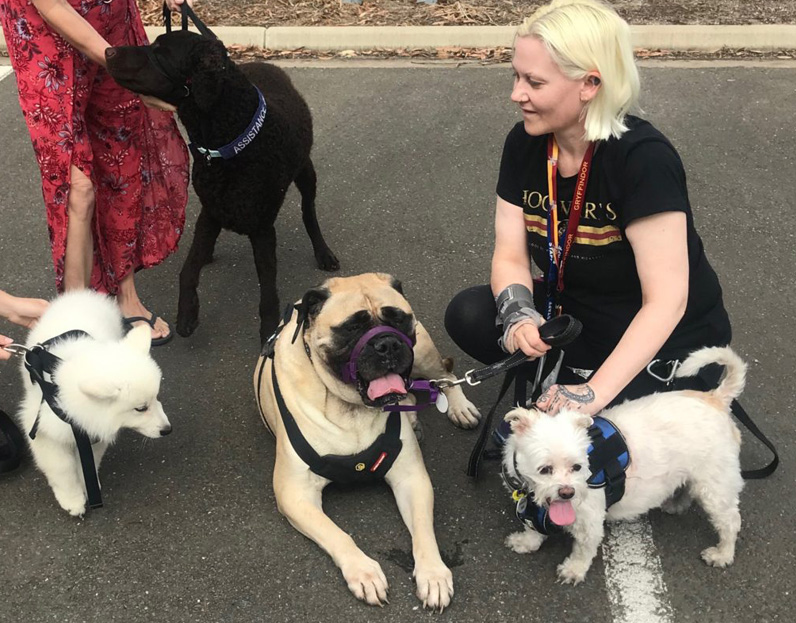Assistance dog refusals and misunderstandings about their legal status occur in all aspects of public life. Emergency services agencies are not immune to this problem, given the quick decisions that need to be made under duress.
Misunderstandings about assistance dogs have real-life consequences about public access. Clarifying the legal definition and characterises of an assistance dog, and debunking concerns about ‘fake’ assistance dogs, will improve understanding of what can be expected of assistance dogs generally. This is of particular importance where an individual is seeking refuge or support during a disaster.
As per the Disability Discrimination Act 1992 (Cth), Section 9 (Commonwealth of Australia 19921), an assistance animal is a dog (or other animal) that falls under at least one of the stated criteria: relevant accreditation under state or territory law, trained by a relevant animal training organisation, or trained to assist a person with a disability to alleviate the effect of the disability. In Australia, the states and territories have different regulations and accreditations of assistance animals. State/territory accreditation is just one way of meeting the Act criteria, and either private training or the use of a training organisation are the others. Animals that are pets are not covered under the Act. An institutional or therapy animal is also not covered unless they are acting in the capacity of an assistance dog for a person defined by the Act.
Assistance dogs are expected to be hygienic, trained and acceptably behaved in public, as stated in the Act, in order to be covered. For emergency situations, this can reasonably translate to the animal being free of communicable disease (e.g. mange, avian virus), clean (as situationally possible), does not exhibit aggressive behaviour (e.g. does not snarl or snap), does not act in unacceptable ways (e.g. jumping on non-handlers), makes minimal disruptive noise (unless alerting) and is under the control of its owner (whether through verbal, signed or physically tethered methods). Furthermore, an assistance dog handler may have an ID card, an identifying coat/leash/tag for their dog, and/or online identification; however, these are not specified by the Act but are useful for identifying the dog in public situations. An assistance dog handler is usually also able to produce evidence of meeting Act requirements by possessing a clinician’s letter, a doctor’s letter, a veterinary clearance of fitness and cleanliness, and possibly training records (held by the person or training organisation). However, this evidentiary paperwork is not typical carried daily by the person and may be less readily available in an emergency or evacuation situation.
There are many breeds of dog used for assistance work. The training and tasks that characterise an assistance dog are varied. Different tasks address different types of disability of its owner. People often picture a guide dog as representative of assistance dogs when, in reality, the breed, breadth of training and range of behaviours that characterise a guide dog are not necessary nor appropriate for dogs serving other disability needs. For example, an ‘alerting’ dog may be trained to bark, jump, climb or lick their owner to draw their attention, or they can be trained to break from a heel position to orient themselves in a protective way. Another person (and possibly another type of handler or trainer) may see these actions as misbehaving. These examples should act as a cautionary tale against judging the standards of dog training for one type of disability against other disabilities. This will help to avoid assumptions and judgements about assistance dogs.


Training of assistance dogs covers different tasks related to the needs of its owner.
Images: Flinders University
Looking at the discourse around assistance animals, it is easy to see how emergency management personnel may get mixed messages about ‘fake assistance dogs’. For example, Harpur et al. (2018) argued that there are many ‘fraudulent’ dogs: ‘assistance animal misuse is now recognized as a major problem in several countries including Australia and the United States’ (p.80).2 However, evidence supporting this claim leaned heavily on newspaper articles, an informational hearing in the USA (which has different laws to Australia) and a Google search engine query. An Australian study by Howell and Bennett (2022)3 discussed fake assistance dogs but their evidence was limited, relying on an ethics paper, a UK briefing paper, a workshop paper and sampling where few respondents had knowledge or experience of assistance dogs.
Glassey (2021)4 focused on fake assistance dogs. While it is true that we do not know how common ‘fake assistance dogs’ are, given the significant effort and preparation required to work with an assistance dog in public, false claims are likely to be low (Sorenson and Matsuoka 2023).5 We could look to other rates of similar misrepresentation or fraud, such as people driving without a licence, that could be an indicator. According to Sorenson and Matsuoka (2023), the current situation is one of moral panic rather than real threat.
How is this information related to emergency management? A good understanding of assistance dogs matters because perceptions affect decisions. Preconceived ideas, assumptions and information affect people’s behaviours and their treatment of others. The overwhelming majority of assistance dogs are likely to be genuinely trained and accredited through a state organisation. They may be legally required to remain with their handler, so emergency services personnel could err on the side of caution. It is not appropriate nor useful to spend time and resources judging an assistance dog’s credibility. According to Australian Red Cross:
…an evacuee with an assistance animal may not be able to present any evidentiary documentation that their animal is in fact a trained assistance animal. However if a person tells you it is an assistance animal it should be treated as such.(Red Cross 2017, p.1)6


